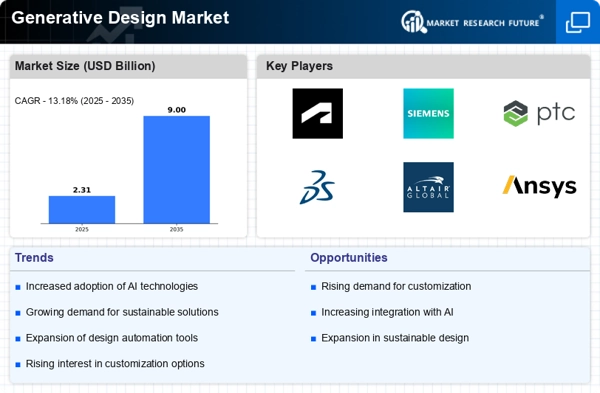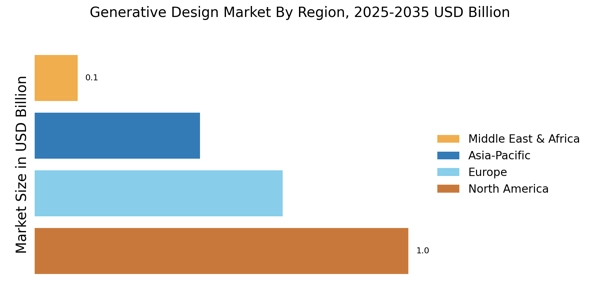Rising Demand for Customization
The Generative Design Market experiences a notable increase in demand for customized products across various sectors, including automotive, aerospace, and architecture. As consumers and businesses seek unique solutions tailored to specific needs, generative design technologies facilitate the creation of highly personalized designs. This trend is supported by data indicating that the customization market is projected to grow significantly, with estimates suggesting a compound annual growth rate of over 20% in the coming years. The ability to rapidly prototype and iterate designs using generative algorithms allows companies to respond swiftly to market demands, thereby enhancing their competitive edge. Consequently, the Generative Design Market is likely to expand as more organizations adopt these innovative design methodologies to meet the evolving preferences of their clientele.
Collaboration Across Disciplines
The Generative Design Market is increasingly characterized by collaboration across various disciplines, including engineering, architecture, and software development. This interdisciplinary approach allows for the integration of diverse perspectives and expertise, leading to more innovative design solutions. Data indicates that projects involving cross-disciplinary teams tend to achieve higher levels of creativity and problem-solving effectiveness. As organizations recognize the value of collaborative efforts, they are likely to invest in platforms and tools that facilitate communication and cooperation among different stakeholders. This trend not only enhances the capabilities of the Generative Design Market but also fosters a more holistic approach to design, ultimately resulting in superior products and solutions.
Advancements in Computational Power
The Generative Design Market is significantly influenced by advancements in computational power, which enable more complex simulations and design iterations. As hardware capabilities improve, designers can leverage sophisticated algorithms to explore a broader range of design possibilities. This trend is evidenced by the increasing availability of high-performance computing resources, which are becoming more accessible to small and medium-sized enterprises. The ability to process vast amounts of data in real-time allows for the optimization of designs that were previously unattainable. As a result, the Generative Design Market is poised for growth, as organizations harness these technological advancements to enhance their design processes and achieve superior outcomes.
Integration of Sustainable Practices
Sustainability has emerged as a pivotal driver within the Generative Design Market, as organizations increasingly prioritize eco-friendly practices. Generative design methodologies facilitate the creation of products that minimize material waste and energy consumption, aligning with global sustainability goals. Data suggests that companies adopting sustainable design practices can reduce material usage by up to 50%, thereby lowering their environmental impact. This shift towards sustainability not only meets regulatory requirements but also resonates with environmentally conscious consumers. As a result, the Generative Design Market is likely to witness a surge in demand for solutions that integrate sustainable practices, reflecting a broader commitment to responsible manufacturing and design.
Increased Investment in Research and Development
The Generative Design Market is benefiting from increased investment in research and development across various sectors. Companies are recognizing the potential of generative design technologies to drive innovation and improve product performance. This trend is supported by data indicating that R&D spending in the manufacturing sector has seen a steady rise, with projections suggesting a continued upward trajectory. As organizations allocate more resources to explore generative design applications, they are likely to uncover new opportunities for efficiency and creativity. This influx of investment not only enhances the capabilities of the Generative Design Market but also fosters a culture of innovation that can lead to groundbreaking advancements in design methodologies.


















Leave a Comment